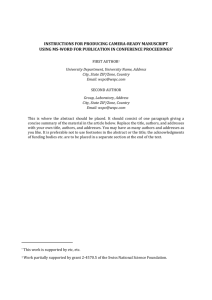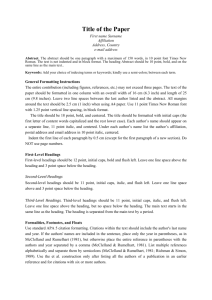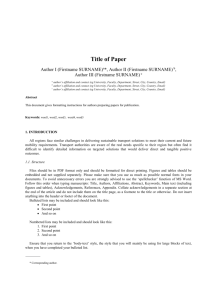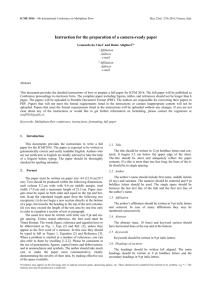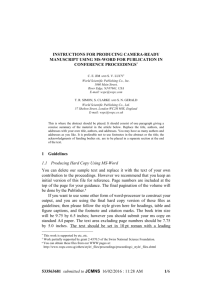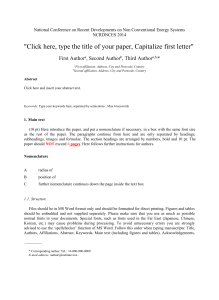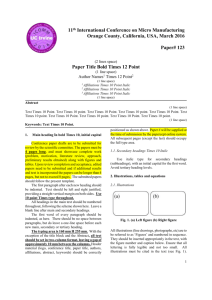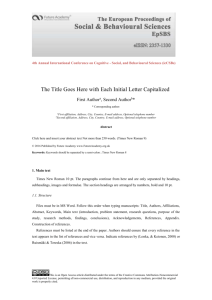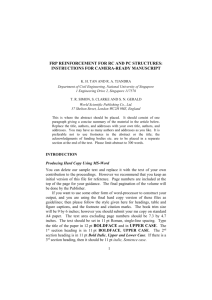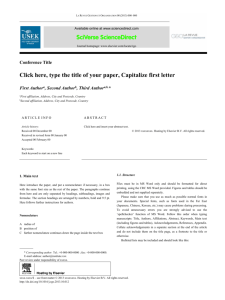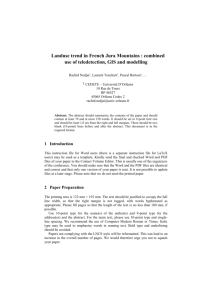ws-procs9x6
advertisement
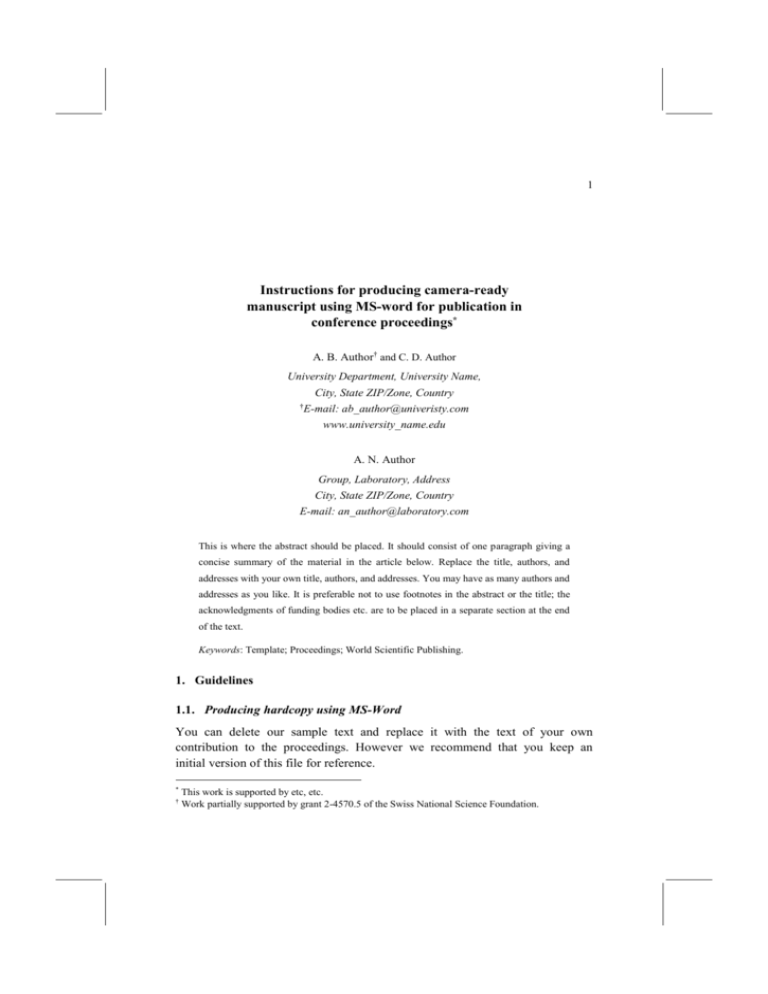
1 Instructions for producing camera-ready manuscript using MS-word for publication in conference proceedings* A. B. Author† and C. D. Author University Department, University Name, City, State ZIP/Zone, Country †E-mail: ab_author@univeristy.com www.university_name.edu A. N. Author Group, Laboratory, Address City, State ZIP/Zone, Country E-mail: an_author@laboratory.com This is where the abstract should be placed. It should consist of one paragraph giving a concise summary of the material in the article below. Replace the title, authors, and addresses with your own title, authors, and addresses. You may have as many authors and addresses as you like. It is preferable not to use footnotes in the abstract or the title; the acknowledgments of funding bodies etc. are to be placed in a separate section at the end of the text. Keywords: Template; Proceedings; World Scientific Publishing. 1. Guidelines 1.1. Producing hardcopy using MS-Word You can delete our sample text and replace it with the text of your own contribution to the proceedings. However we recommend that you keep an initial version of this file for reference. * † This work is supported by etc, etc. Work partially supported by grant 2-4570.5 of the Swiss National Science Foundation. 2 Page numbers are included at the top of the page for your guidance. The final pagination of the volume will be done by the Publisher. If you want to use some other form of word-processor to construct your output, and you are using the final hard copy version of these files as guidelines; then please follow the style given here for headings, table and figure captions, and the footnote and citation marks. The book trim size will be 9 by 6 inches; however you should submit your ms copy on standard A4 paper. The text area including page numbers should be 7.35 by 4.5 inches, except for opening page. The text should be set in 10 pt roman with a leading (interline spacing) of 13 pt. Type the title of the paper in 11 pt boldface and in title case. The 1st section heading is in 10 pt boldface, upper and lower case. The 2 nd section heading is in 10 pt bold italic, upper and lower case. If there is a 3 rd section heading then it should be 10 pt italic. Authors’ names are set in 9 pt and in upper case. Addresses are in 9 pt italics. The abstract, figure and table captions should be in 8 pt. It is also important to reproduce the spacing of the text and headings as shown here. Text should be slightly more than single-spaced; use a leading (which is the average distance from the base of one line of text to the base of an adjacent line) of 13 pt and 10 pt for footnotes. All headings should be separated from the text preceding it by a vertical space of about 12 pt and by 6 pt from the subsequent text. Paragraphs should have its first line indented by about 0.25 inch except where the paragraph is preceded by a heading and the abstract should be indented on both sides by 0.25 inch from the main body of the text. 2. Major Headings Major headings should be typeset in boldface with the first letter of important words capitalized. 2.1. Sub-headings Sub-headings should be typeset in boldface italic and capitalize the first letter of the first word only. Section number to be in boldface roman. 2.1.1. Sub-subheadings Typeset sub-subheadings in medium face italic and capitalize the first letter of the first word only. Section numbers to be in roman. 3 3. Equations Equations should be centered and numbered consecutively, as in Eq. (1). I P k , m , M (21 ) 2 i 2 i 3 d k 2 P k . i 5 4 i (1) i Punctuation marks are used at the end of equations as if they appeared directly in the text. 4. List Lists may be laid out with each item marked by a dot: item one, item two, item three. Alternatively items may also be numbered in lowercase Roman numerals: (i) item one, (ii) item two, (a) lists within lists can be numbered with lowercase alphabets, (b) second item. (iii) item three, (iv) item four. or (1) item one, (2) item two, (a) lists within lists can be numbered with lowercase alphabets, (b) second item. (3) item three, (4) item four. 5. Theorems and Proofs Theorem 5.1. Theorems, lemmas, definitions, etc. are set on a separate paragraph, with extra 1 line space above and below. They are to be numbered consecutively within each section. 4 Numbering by sections refers only to the large main sections, i.e. to those with Level 1 headings. Thus the numbering style in Sec. 5 would be labeled (5.1), (5.2), etc. Lemma 5.2. Theorems, lemmas, definitions, etc. are set on a separate paragraph, with extra 1 line space above and below. They are to be numbered consecutively within each section. Numbering by sections refers only to the large main sections, i.e. to those with Level 1 headings. Thus the numbering style in Sec. 5 would be labeled (5.1), (5.2), etc. Proof. Proofs should end with a square box 6. Tables The tables are designed to have a uniform style throughout the paper? It does not matter how you choose to place the inner lines of the table, but we would prefer the border lines to be of the style shown in Table 1. For the inner lines of the table, it looks better if they are kept to a minimum. The caption heading for a table should be placed at the top of the table. Table 1. This is the caption for the table. If the caption is less than one line then it is centered. Long captions are justified to the table width manually. Schedule Business plan Production planning Final assembly schedule Master production schedule (MPS) Stock picking schedule Order priorities Scheduling Operation sequencing Capacity Level a Financial planning Resource requirement plan (RRP) Capacity control Rough cut capacity plan (RCCP) Inventory control Factory order control Machine (work-centre) control Tool controlb Planning Execution Note: Table notes. a Sample footnote A. b Sample footnote B. 7. Figures/Illustrations Authors are advised to prepare their figures in black and white. Please prepare the figures in high resolution (300 dpi) for half-tone illustrations or images. Half-tone pictures must be sharp enough for reproduction, otherwise they will be 5 rejected. Colour images are allowed only when they are stated in the publishing agreement. The colour images must be prepared in CMYK (Cyan, Magenta, Yellow and Black). RGB colour images are not acceptable for colour separation. It is best to embed the figures in the text where they are first cited, e.g. see Figure 1. Please ensure that all labels in the figures are legible regardless of whether they are drawn electronically or manually. Fig. 1. This is the caption for the figure. If the caption is less than one line then it needs to be manually centered. If you prefer to submit glossy prints of figures, then it is very important to leave sufficient blank spaces in your manuscript to accommodate your figures. Send the hard copy of the figures on separate pages with clear instructions on where to match them to the respective blank spaces in the final hard copy text. Please ensure that each figure is correctly scaled (ensure legibility) to fit the space available. The caption heading for a figure should be placed below the figure. Very large figures and tables should be placed on a page by themselves. 8. Acknowledgments, Appendices, Footnotes and the Bibliography If you wish to acknowledge funding bodies etc., the acknowledgments may be placed in a separate section at the end of the text, before the Appendices. It is preferable not to have Appendices in a brief article, but if more than one Appendix is necessary then set headings as Appendix A, Appendix B etc. 9. Footnotes and Citation Footnotes are denoted by a character superscript in the text, b and references are denoted by a number superscript.1 If you use square brackets for citation e.g. [2] b Just like this one. 6 please note that the citation should appear before the punctuation mark, e.g. [2], in the body text. 10. Final Manuscript The final hard copy that you submit must be absolutely clean and unfolded. It will be printed directly without any further editing. Use a printer that has a good resolution printout (600 dpi or higher). There should not be any corrections on the printed pages, nor should adhesive tape cover any lettering. Photocopies are not acceptable. Your manuscript will not be reduced or enlarged when filmed so please ensure that indices and other small pieces of text are legible. Acknowledgments This is where one acknowledges funding bodies etc. Note that section numbers are not required for Acknowledgments, Appendix and References. Appendix Appendices should be used only when sophisticated technical details are crucial to be included in the paper. If there is more than one appendix, number them alphabetically. 1(d t N (d ) n) . 1( N ( ) n)d (n t ) i 1 t i i (A.1) 0 References 1. 2. 3. 4. 5. L. Lamport, LaTeX, A Document Preparation System, 2nd edn. (AddisonWesley, Reading, MA, 1994). AMS, AMS-LaTeX Version 2 User's Guide (American Mathematical Society, Providence, 2004), http://www.ams.org/tex/amslatex. html. C. Jarlskog, CP Violation (World Scientific, Singapore, 1988). B. W. Bestbury, R-matrices and the magic square, J. Phys. A 36, 1947 (2003). P. X. Deligne and B. H. Gross, On the exceptional series, and its descendants, C. R. Math. Acad. Sci. Paris 335, 877 (2002). 7 6. 7. 8. 9. 10. 11. 12. 13. 14. 15. 16. 17. 18. 19. J. M. Landsberg and L. Manivel, Triality, exceptional Lie algebras and Deligne dimension formulas, Adv. Math. 171, 59 (2002), http://www. url.com/triality.html. G. H. Weiss (ed.), Contemporary Problems in Statistical Physics (SIAM, Philadelphia, 1994). R. K. Gupta and S. D. Senturia, Pull-in time dynamics as a measure of absolute pressure, in Proc. IEEE Int. Workshop on Microelectromechanical Systems (MEMS'97), (Nagoya, Japan, 1997). L. F. Richardson, Arms and Insecurity (Boxwood, Pittsburg, 1960). R. V. Churchill and J. W. Brown, Complex Variables and Applications, 5th edn. (McGraw-Hill, 1990). F. Benhamou and A. Colmerauer (eds.), Constraint Logic Programming, Selected Research (MIT Press, 1993). D. W. Baker and N. L. Carter, Seismic Velocity Anisotropy Calculated for Ultramafic Minerals and Aggregates, in Flow and Fracture of Rocks, eds. H. C. Heard, I. V. Borg, N. L. Carter and C. B. Raleigh, Geophys. Mono., Vol. 16 (Am. Geophys. Union, 1972), pp. 157–166. J. D. Hobby, A User's Manual for MetaPost, Tech. Rep. 162, AT&T Bell Laboratories (Murray Hill, New Jersey, 1992). B. W. Kernighan, PIC—A Graphics Language for Typesetting, Computing Science Technical Report 116, AT&T Bell Laboratories (Murray Hill, New Jersey, 1984). H. C. Heard, I. V. Borg, N. L. Carter and C. B. Raleigh, VoQS: Voice Quality Symbols, Revised to 1994, (1994). M. E. Brown, An interactive environment for literate programming, PhD thesis, Texas A&M University, (TX, USA, 1988), pp. ix + 102. G. S. Lodha, Quantitative interpretation of ariborne electromagnetic response for a spherical model, Master's thesis, University of Toronto (1974). D. Jones, The term ‘phoneme’, in Phonetics in Linguistics: A Book of Reading, eds. W. E. Jones and J. Laver (Longman, London, 1973) pp. 187–204. B. Davidsen, Netpbm (1993), ftp://ftp.wustl.edu/graphics/ graphics/packages/NetPBM.
